With contributions from Scott Pinkelman
In 1982 Afrika Bambaata dropped the track Planet Rock, a song that brought the words of the Bronx-based Zulu Nation to all audiences and was, as hip hop historian Jeff Chang describes it, a “hypnotic vision of one world under one groove, beyond race, poverty, sociology, and geography.” Twenty-eight years later, in 2010, Bambaata’s message was alive and well in Santiago, Chile in the form of a week long Hip Hop Festival aptly named Planeta Rock. Planeta Rock celebrated all the five elements of hip hop; knowledge, break dancing, graffiti, mc’ing, and djaying. While knowledge is often the forgotten element, it was clear that at Planeta Rock it was central pillar, where commercialization has yet to influence its form and content, and the lyrics bombast the powers that be.
The festival opened with the Fiesta Zulu and a message from Afrika Bambaata, sending shout outs from the Bronx down to Santiago and all those that are following in the footsteps of the Zulu Nation. Breakdancers abounded, rocking Six Step, Zulu Spins, and Windmills. This setting could have been anywhere; the break beat pulsed throughout the crowd and hundreds of youth continued to rock it till the wee hours of the night. The political nature and uniqueness of Chilean’s political hip hop scene became more apparent during a release of a book entitled From Message to Action that chronicles political hip hop in Chile. Films shown at the gathering included a smattering of graffiti, music, and break dancing videos from Latin America that were juxtaposed among short political documentaries highlighting land occupations throughout Chile, the plight of political prisoners and the struggles of the indigenous Mapuche people.
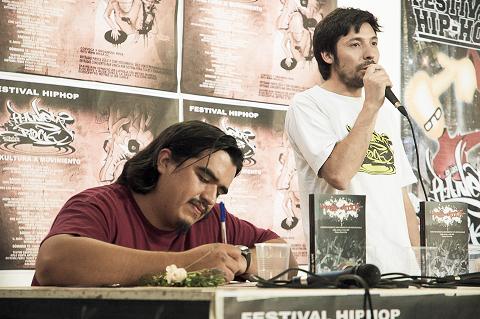
Photo: Members of the Hip Hop Activist Network present the book From Message to Action.
At a similar film event at Planeta Rock, a highlight of the night was the music video 1500 días, which held a match to all the false campaign promises of the presidential candidates. Just the week before this gathering, the right-wing candidate and media mogul Sebastian Piñera had won the elections. The song lays into the neoliberal policies that all the presidential candidates have pushed, proclaiming that they won’t participate in the elections of the rich, and that the 1500 days between elections should serve as 1500 days of organizing and struggle. In a country where 40% of the population is not even registered to vote, these lyrics have widespread resonance.
In Chile, as in many parts of the world, hip hop is its own form of independent media – the people’s resistance to the right-wing controlled media. Regarding this, Dj Erko, one of the organizers of Planeta Rock 2011 referenced a quote by old school NY political group Public Enemy “As Chuck D said, rap is the CNN of black folks. In our cases it’s the CNN of the neighborhood, the barrio of the oppressed. Hip Hop has had the capacity to be a tool of contra-information, propaganda, education and knowledge.”
In 2011 rappers Subverso and Portavoz, who wrote 1500 days, have taken their political critique to the next level with the project, Memoria Rebelde, or Rebel Memory, which seeks to teach Chilean history through hip hop and multimedia. Portavoz says the inspiration for this project goes back to the origins of hip hop. “In the Bronx, Harlem or whichever ghetto, there were many Latin American immigrants and black people who used hip hop to denounce what was happening and also as a way to share their experiences as black people, as immigrants, and as oppressed people. We are trying to rescue this form of popular education and use rap as a powerful tool to tell the story of our people.” They released a Memoria Rebelde video at Planeta Rock declaring their refusal to celebrate Chile’s bicentennial while thousands of people continue to be oppressed. They also pointed out the government’s hypocrisy of celebrating the rescue of 33 miners who had been trapped when the country’s history is stained with massacres of miners organizing for workers rights. Subverso says they wrote the song so that people can “recognize the true history of our land and its people” and thank all the “true historians of the people who have been illuminating the dark corners where the poor have struggled to forge their own project of liberation.”
If we can learn about the history of Chile through hip hop, what can we learn about the history of hip hop in Chile? In many countries where hip hop is true to its elements, it is a recently-arrived art form. Yet in Chile, hip hop arrived 25 years ago when the country was living under the brutal dictatorship of President Augusto Pinochet. Pinochet’s government came to power in a US backed coup d’etat in 1973, which overthrew and assassinated socialist president Salvador Allende and was responsible for the deaths and disappearances of thousands of students, union members, campesinos, intellectuals, leftists politicians, and musicians.
It was in this setting that the first beats of hip hop trickled down to Chile. Legend has it that one Public Enemy tape arrived and instantly hundreds of copies were made, spreading like wildfire through the poblaciones or poblas (marginalized neighborhoods) of Santiago, where the lyrics and beats resonated just as they had across the ghettos of the United States. Hip Hop tapes started replacing other tapes by those who secretly listened to Victor Jara, Inti Illimani, and other folk music of the Nueva Canción movement that had been on heavy rotation among the dictatorship’s resistance. Hip Hop ceased being a clandestine art form, when classic hip hop films Beat Street and Breakdance aired on national television and breakdancing entered the public consciousness. Shortly thereafter, breakers hit the street corners in downtown Santiago, contorting their bodies and dancing moves the people had never seen before, but instantly wanted to emulate. Following the spread of Breakdancing, certain Chilean hip hop groups broke out on the scene including Panteras Negras, who clearly took inspiration from the US-based Black Liberation movement and a few years later Makiza, that featured the currently globally popular Anita Tijoux who performs at Planeta Rock every year.
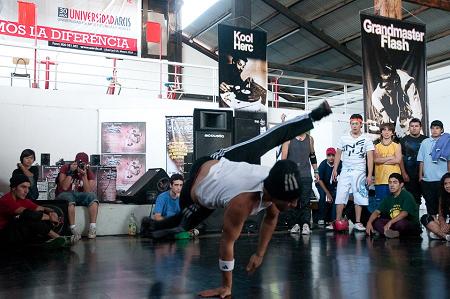
Photo: A Breaker dances at Planeta Rock alongside banners celebrating Bronx Hip Hop legends.
Bufonk is an MC who has been involved with various hip hop collectives over the years. He and his brother, who is also the well known MC Guerrillero Okulto, grew up in a “tomada,” an urban land occupation, where many of Santiago’s poorest people lived, in shacks, without running water, electricity and general city infrastructure. Pinochet not only repressed all leftist dissent but also ushered in neoliberal reforms, which privatized businesses expropriated by the Allende government, lowered wages and encouraged foreign bank loans. The beneficiaries of this new economy—including Pinochet and his family—became known as the piranhas and made millions while the majority of Chileans saw their standard of living drop. These policies were continued after the military government, and today Chile’s export-oriented economy is one of the most unequal in Latin America.
When I asked Bufonk why the hip hop scene and lyrics were so anti-capitalist he responded. “The poverty that we experienced was a direct result of neoliberalism and capitalism. Living in those conditions, how could we then turn around and perpetuate capitalism?”
Not only do many Chilean hip hop artists rap about the injustices inherent in the new world order, but they also manifest it in the way they organize concerts, events and share music. At Planeta Rock, it was easier to buy an ice cream than a hip hop CD, as most share their music through free downloads on the internet.
Lah Tere, a member of the US based Afro-Boricuan/Chilean hip hop trio Rebel Diaz performed at Planeta Rock in 2010. She said “This doesn’t even happen in the Bronx where hip hop started. The youth aren’t connected like they are here with hip hop and knowledge. Everywhere you look there is a cypher going on with kids b-boxing and rapping. There is true leadership, loyalty, pride and people are excited about their culture and participate in things.”
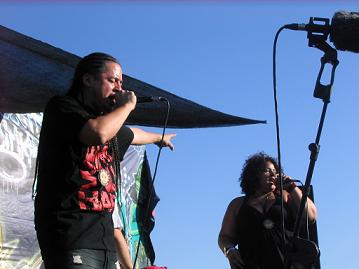
Photo: Rod Starz and Lah Tehre of Rebel Diaz rock it on the stage at Planeta Rock 2010
It is clear that these festivals are a culmination of year-long hip hop education facilitated by the Red de Hip Hop Activista (RH2A) – (Hip Hop Activist Network), who organize the Planeta Rock festival. Satyra, age 21, is one of nine collective members of the RH2A , and says that with knowledge as a key element of hip hop, it’s crucial that they lead educational workshops in the poblas.
Satyra, a university student who studied education and psychology, spoke of how the Chilean education system’s top-down neoliberal model fails to engage young people, leading to high drop out rates, which in turn lends itself to drug use, crime, imprisonment and furthers their marginalization. This situation is hardly unique to Chile, yet here these hip hop activists have chosen to specifically engage those disenchanted with formal education and attempt to engage them with the dynamic elements of hip hop. Taking inspiration from the educational theories of Brazilian philosopher Paolo Freire, they lead popular education workshops where the facilitators and participants are on equal ground both teaching and learning. Freire says popular educators “fight alongside the people for the recovery of the people’s stolen humanity” and here in these hip hop workshops R2HA facilitators and young participants together tackle complex subjects, including Chilean history, the resistance struggles of the indigenous Mapuche, or current land and housing struggles. Satyra says she got her start with the hip hop movement as a graffiti artist and then got more involved with the organizing side, helping with a lot of the behind the scenes work for the shows, festivals, and facilitating the pobla workshops.
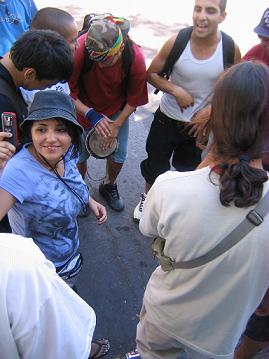
Photo: Everywhere you turn during Planeta Rock workshops, concerts and parties you can see people cyphering, sharing beats and rhymes.
This horizontal philosophy not only manifests itself in the workshops, but also in the whole organizing model of the hip hop activist network, according to Satyra, who says it’s crucial to organize in a non-hierarchical fashion so everyone’s opinions are respected and valued. “If you’re 15 years and you’ve spent your whole life being punished by your parents, why would you want to then join an organization where you have someone else telling you what to do, replicating the same hierarchy you were trying to escape from at home?”
Ironically, it seems as if much of this behind the scenes logistical organizing is done by women while those at the visible forefront of the event, mc’ing on stage, appearing on promotional flyers, and speaking on educational panels are all male. While it appears to me that patriarchy is alive and flourishing, Satyra counters my criticism by saying “You can’t blame hip hop, it’s not our movement, it’s society at large that is full of machismo, and therefore hip hop replicates it.” However, while it seems that R2HA has strategized many ways to reach young folks, they haven’t put the same intentionality into involving women, and I didn’t hear about any workshops or events specifically aiming at breaking down gender barriers within the movement.
While the Hip Hop Activist network employs these collective models of organizing, another hip hop collective who broke away from the R2HA over philosophical differences takes organizing into a collective home and cultural center. At the corner of Cueto con Andes in Barrio Brazil, one of Santiago’s oldest neighborhoods, lies a beautifully graffitied hip hop social center. It is a living example of autogestión which can be loosely translated as worker self-management with a foundation in anarcho-syndicalist struggles and autonomy from the state. At Cueto con Andes all collective members support themselves and the house by selling home baked bread, fruit juices, soy burgers, or silkscreening t-shirts and posters.
On a weekly basis, 20 or so graffiti artists gather there. Many participants are part of the crew 12 Brillos, who plan events such as Planeta Graff, a parallel event to Planeta Rock, with spray paint workshops and murals in collaborations with marginalized communities across Chile. Planeta Graff brings together hundreds of “graffiteros” from all over Chile to take over a street in Santiago and paint pieces that greatly differ from the common U.S. style, where pieces feature flora, fauna, people, cartoons, landscapes and more, and are rarely focused on the individual artists and their name/tag.
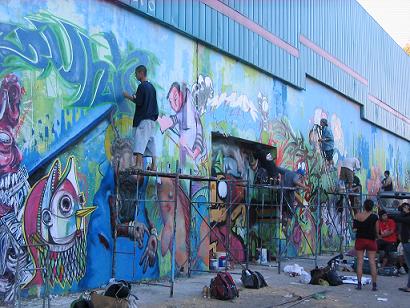
Photo: Graffiti artists collaboratively paint a wall in Santiago during the multi-day Planetta Graff festival.
Every Saturday Cueto con Andes hosts a Dj workshop where boys (although I’m told that occasionally women come) ranging from age 10 – 30 bring a random assortment of vinyl from classic hip hop to Latino punk legends Los Crudos, to ubiquitous thrift store artists Herb Albert and the Tijuana Brass and take a turn at the decks. The workshop opens with the classic scene from Wild Style where Grandmaster Flash shows off his baby scratch but then transitions into something more profound. A triangle is formed with a string connecting a shovel, a book and a paintbrush. The participants start in the middle of the circle and each one has to attempt to grab one of the objects. A discussion then ensues about how it was much easier for them to get the objects, when they all moved together instead of apart, and how society tries to divide the intellectuals, the workers, and the artist and really they should all be working together.
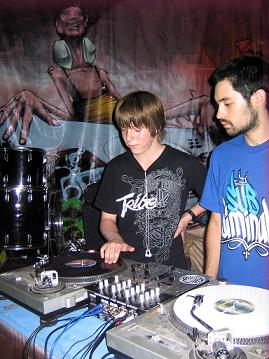
Photo: In the weekly Dj workshop at Cueto con Andes social Center participants learn the baby scratch
Cueto con Andes is also home to a Pirate Community Television Station, and throughout the year the Tergiversarte free school hosts workshop series on audio recording techniques, video production, gardening permaculture, and more. Habitual, an Mc and media maker who is one of the driving forces behind these workshops and the cultural center, says “We believe in autogestión and it is the only way that you can do what you want to do. It allows us to create hip hop in the manner that we want to create. We believe in people. And that with our own hands and our own needs we can produce.” He says he has seen the long term effects of their Tergiversarte free school, with youth instantly becoming involved in the organization after they attend a workshop.
When one views this huge do-it-yourself political hip hop movement, it’s hard to not wonder if it will meet the same sad fate as hip hop in the US, where messages of struggle have been silenced and taken over by the bling-bling of a hyper capitalist, exploitative hip hop market. Habitual assures me that won’t happen to them: “Capitalism always tries to co-opt subcultures and drive it in a certain direction to function in its interest. The market is always looking to where it can drink more blood – but we don’t agree with the market logic.” He adds “Hip Hop reflects values that we identify with to transform the logic of capitalism and social relationships. It allows us to share, it is a means of expression, rebellion and transformation.”
If you step back from this hip hop movement and think of Chile at large, and the battles waged daily by Mapuche people on hunger strikes fighting for their land and culture, students filling the streets against rising tuition, and then walk the streets of Santiago passing by the radical political sloganeering graffiti that dots every street corner, you can imagine that as long as the people keep fighting, political anti-capitalist hip hop will thrive and grow.
Andalusia Knoll is a multimedia journalist, popular educator and organizer. She is a producer with the national Criminal Justice Dialogue Project Thousand Kites, a reporter for various news outlets including Free Speech Radio News, Radio Bilingue and TeleSUR and an organizer with the NYC Community/Farmworker Alliance who work in alliance with The Coalition of Immokalee Workers.
